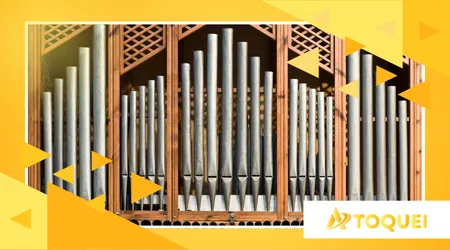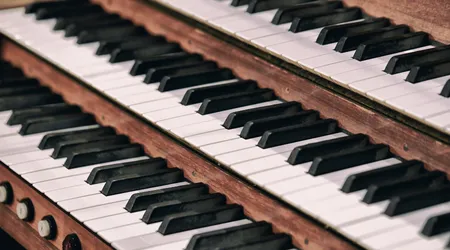How the pipe organ works and its sound complexity

The sonic grandeur becomes curious in how the pipe organ works, not only in the volume it reaches, but mainly in its extraordinary timbral versatility.
Advertisements
No other keyboard instrument offers such a range of colors and textures. The organ can sound like a delicate flute solo, an imposing brass ensemble, or a full orchestra.
Their ability to sustain sound continuously and powerfully is legendary. The complexity of their physical and acoustic design makes each organ a truly unique creation.
The secret behind the majestic sound lies in its ingenious pneumatic system and the action of its numerous tubes.
The process begins with a constant supply of compressed air, the “wind”, now guaranteed by an electric motor and bellows.
Advertisements
This air is stored in reservoirs to maintain an absolutely stable pressure, crucial for sound quality.
The organist presses the keys and registers, which are levers or buttons that select the rows of pipes.
What is the Role of Records in Sound Creation?
The registers act as if they were the conductors of an orchestra, defining which sets of pipes will sound.
Each register corresponds to a specific timbre, such as flutes, strings or trumpets, and has a tube for each note on the keyboard.
When the musician “pulls” a register, he enables the passage of air to that particular series of tubes.
This combination of registers allows the organist to create rich and varied sonic textures in real time.
Read more: What is balafon, the “African xylophone”?
Pressing a key opens a valve below the corresponding tube, allowing pressurized air to pass through.

How Does Acoustic Engineering Define the Timbre of Each Tube?
The tubes are the sonic heart of the instrument, true resonators that transform airflow into musical notes. They are classified into two main types: labial and reed.
++ Bagpipes: history, types and curiosities
Lip pipes, like a recorder, produce sound by breaking air against a lip. Reed pipes contain a vibrating blade, similar to that of a clarinet, giving a more penetrating timbre.
The material (metal or wood), shape and length of each tube determine the pitch of the note and its sound color.
It is the sum of thousands of these elements that gives the instrument its sound complexity.
Why is the Pipe Organ Comparable to a Symphony Orchestra?
The comparison is not an exaggeration, but an accurate analogy of the instrument's sonic capacity.
The organist, when manipulating the various manuals (keyboards) and the pedal board, is, in practice, conducting different sections of a musical body.
++ What is a dulcimer and where is it still used?
The pedalboard, played with the feet, controls the larger tubes, responsible for the lower sounds and the harmonic foundation.
The manuals control the midrange and treble pipes. An experienced organist might, for example, simulate the string section on one keyboard, the woodwinds on another, and the brass in the main registers.
This simultaneity of timbres and the independent control over them is what defines How the pipe organ works and its wealth.
| Instrument Family (Orchestra) | Timbric Family (Pipe Organ) | Dominant Sound Characteristic |
| Strings (Violins, Cellos) | Strings (Salitional, Gamba) | Soft, Expressive, Tenuous |
| Woodwinds (Flutes, Clarinets) | Flutes (Flûte Harmonique, Bourdon) | Shiny, Smooth, Hollow |
| Brass (Trumpets, Trombones) | Principals/Reed (Trumpet, Principal) | Powerful, Grounds the Sound |
| Percussion (Timpani) | 32′ and 16′ registers (Pedal) | Deep, Low Resonance |
What is the Impact of Architecture and Space on Sound?
The pipe organ is an instrument intrinsically linked to the architecture in which it is installed. Its sound does not exist in a vacuum; the building is an integral part of the acoustic system.
++ THE organ is a musical instrument of the keyboard aerophone family
The natural reverberation of cathedrals and concert halls directly influences the perception of sound.
An organ designed for a Gothic church with high reverberation will sound different in a dry, modern room.
It's a unique synergy between the instrument, the organist, and the physical space. The organ builder is also an acoustic architect.
What Does the Future Hold for the Pipe Organ?
In a world dominated by synthesizers and digital music, the pipe organ maintains its relevance.
His authentic and inimitable voice resonates in new contexts. Contemporary musicians explore the instrument in genres beyond classical, embracing experimentation.
The installation of new organs in contemporary spaces, such as the Evangelical Cathedral of São Paulo (with 3,575 pipes), inaugurated in 2019, demonstrates their ongoing role.
The organ's ability to simulate a thunderstorm or birdsong with just airflow, without digitization, is a testament to its genius.
How the pipe organ works it is a lesson in physics and musicality.
In short, the pipe organ is not just an instrument, but a complete musical ecosystem, challenging the player and involving the listener in an immersive and timeless experience.
Its complex sound continues to fascinate.
How the Pipe Organ Works: Understanding Magnitude
To illustrate its magnitude: consider an organist playing a 16-foot stop. This note sounds an octave lower than traditional notation.
It's as if the lowest part of an orchestra were being played by a single person, with the depth of a double bass and the power of a choir.
The ability to instantly switch between smooth and thunderous timbres is what defines How the pipe organ works.
A notable statistic, according to The Organ Historical Society in the United States, is that about 65% of the pipe organs in the country have fewer than 2,000 pipes, but even these “small” organs require maintenance and technical expertise unmatched by other instruments.
The organ remains the pinnacle of mechanical and acoustic complexity. Would it be possible to replicate all this richness with a simple electronic keyboard?
The answer lies in the vibrant soul of each tube.
Conclusion: The Inimitable Voice of the King
The pipe organ transcends the definition of a simple musical instrument. It is a sonic monument.
Its complexity, from the air supply system to the unique resonance of thousands of pipes, guarantees a timbral richness that echoes through the centuries.
Master and understand How the pipe organ works is to unveil one of humanity's most impressive inventions, a legacy of sound and engineering.
He continues to inspire, challenging digital music with the authenticity and depth of his pneumatic voice.
Frequently Asked Questions
What are the “feet” on an organ stop?
The “feet” indicate the length of a register’s tube and, consequently, the pitch of the note it produces.
An 8-foot (8′) stop sounds the actual pitch of the note on the keyboard. A 16-foot stop sounds an octave lower, and a 4-foot stop sounds an octave higher.
What is the difference between a mechanical and an electric pipe organ?
The main difference lies in the traction, the system that connects the keys to the air valves. In a mechanical organ (or mechanical traction), this connection is physical, through rods and levers (actuation).
In electropneumatics, an electrical impulse actuates a pneumatic mechanism to open the valves, making the action lighter, but losing some of the direct tactile feedback.
Does the pipe organ need regular tuning?
Yes, absolutely. Due to changes in temperature and humidity, which affect the pipe material (especially metal and wood), the organ needs to be tuned regularly. A specialized tuner must adjust the pitch of each pipe to maintain the instrument's harmony.
Can the organ play different volumes of sound?
Yes, the organist controls volume and expressiveness primarily in two ways: (1) adding or removing stops (more stops = more volume) and (2) using the Expression Box.
The expression box is a closed cabinet containing some tubes, and the organist can open and close its shutters (using a pedal) to control the intensity of the sound.
